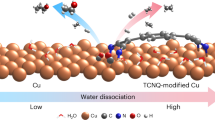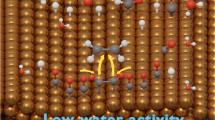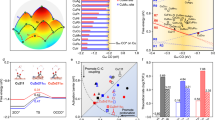Abstract
There is growing interest in the conversion of CO2 and CO into energy-dense multi-carbon products to help mitigate climate change, but guiding selectivity remains challenging due to competing pathways. Here we show that tuning the structure of interfacial water using highly concentrated NaClO4 electrolytes enhances CO electroreduction to C2H4. Increasing the NaClO4 concentration from 0.01 to 10 molal increased the CO reduction rate 18-fold, achieving a Faradaic efficiency of 91% for multi-carbon products at −1.43 V versus the normal hydrogen electrode. Temperature-dependent CO reduction, combined with surface-enhanced Raman spectroscopy, revealed that changes in the interfacial H2O structure correspond to variations in the apparent activation enthalpy and entropy for the reduction of CO to C2H4. At higher ionic strength, increases in activation entropy were linked to disrupted hydrogen bonding and the emergence of non-hydrogen-bonded water modes, suggesting that disordered interfacial H2O layers facilitate CO reduction to C2H4. These findings offer valuable insights into how manipulating the structure of interfacial water can enhance the reduction of CO to multi-carbon products.

This is a preview of subscription content, access via your institution
Access options
Access Nature and 54 other Nature Portfolio journals
Get Nature+, our best-value online-access subscription
$32.99 / 30 days
cancel any time
Subscribe to this journal
Receive 12 print issues and online access
$259.00 per year
only $21.58 per issue
Buy this article
- Purchase on SpringerLink
- Instant access to full article PDF
Prices may be subject to local taxes which are calculated during checkout




Similar content being viewed by others
Data availability
All the data that support the findings of this study are available within the paper and its Supplementary Information. Source data are provided with this paper.
References
Jouny, M., Hutchings, G. S. & Jiao, F. Carbon monoxide electroreduction as an emerging platform for carbon utilization. Nat. Catal. 2, 1062–1070 (2019).
Verma, S., Lu, S. & Kenis, P. J. A. Co-electrolysis of CO2 and glycerol as a pathway to carbon chemicals with improved technoeconomics due to low electricity consumption. Nat. Energy 4, 466–474 (2019).
Li, C. W., Ciston, J. & Kanan, M. W. Electroreduction of carbon monoxide to liquid fuel on oxide-derived nanocrystalline copper. Nature 508, 504–507 (2014).
Murata, A. & Hori, Y. Product selectivity affected by cationic species in electrochemical reduction of CO2 and CO at a Cu electrode. Bull. Chem. Soc. Jpn. 64, 123–127 (1991).
Kim, C. et al. Importance of site diversity and Cconnectivity in electrochemical CO reduction on Cu. ACS Catal. 14, 3128–3138 (2024).
Akbashev, A. R. Electrocatalysis goes nuts. ACS Catal. 12, 4296–4301 (2022).
Li, J., Li, X., Gunathunge, C. M. & Waegele, M. M. Hydrogen bonding steers the product selectivity of electrocatalytic CO reduction. Proc. Natl Acad. Sci. USA 116, 9220–9229 (2019).
Chen, X. et al. Electrochemical CO2-to-ethylene conversion on polyamine-incorporated Cu electrodes. Nat. Catal. 4, 20–27 (2021).
Zhang, H., Gao, J., Raciti, D. & Hall, A. S. Promoting Cu-catalysed CO2 electroreduction to multicarbon products by tuning the activity of H2O. Nat. Catal. 6, 807–817 (2023).
Xie, M. S. et al. Amino acid modified copper electrodes for the enhanced selective electroreduction of carbon dioxide towards hydrocarbons. Energy Environ. Sci. 9, 1687–1695 (2016).
Lai, Y. et al. Breaking scaling relationships in CO2 reduction on copper alloys with organic additives. ACS Cent. Sci. 7, 1756–1762 (2021).
Soucy, T. L., Dean, W. S., Zhou, J., Rivera Cruz, K. E. & McCrory, C. C. L. Considering the influence of polymer–catalyst interactions on the chemical microenvironment of electrocatalysts for the CO2 reduction reaction. Acc. Chem. Res. 55, 252–261 (2022).
Watkins, N. B., Wu, Y., Nie, W., Peters, J. C. & Agapie, T. In situ deposited polyaromatic layer generates robust copper catalyst for selective electrochemical CO2 reduction at variable pH. ACS Energy Lett. 8, 189–195 (2023).
Schreier, M., Kenis, P., Che, F. & Hall, A. S. Trends in electrocatalysis: the microenvironment moves to center stage. ACS Energy Lett. 8, 3935–3940 (2023).
Sha, Y. et al. Anchoring ionic liquid in copper electrocatalyst for improving CO2 conversion to ethylene. Angew. Chem. Int. Ed. 61, e202200039 (2022).
Xing, Z., Hu, L., Ripatti, D. S., Hu, X. & Feng, X. Enhancing carbon dioxide gas-diffusion electrolysis by creating a hydrophobic catalyst microenvironment. Nat. Commun. 12, 136 (2021).
Wang, Y. et al. Strong hydrogen-bonded interfacial water inhibiting hydrogen evolution kinetics to promote electrochemical CO2 reduction to C2+. ACS Catal. 14, 3457–3465 (2024).
Noh, S., Cho, Y. J., Zhang, G. & Schreier, M. Insight into the role of entropy in promoting electrochemical CO2 reduction by imidazolium cations. J. Am. Chem. Soc. 145, 27657–27663 (2023).
Liang, Y. et al. Efficient ethylene electrosynthesis through C–O cleavage promoted by water dissociation. Nat. Synth. 3, 1104–1112 (2024).
Gomes, R. J. et al. Modulating water hydrogen bonding within a non-aqueous environment controls its reactivity in electrochemical transformations. Nat. Catal. 7, 689–701 (2024).
Pérez-Gallent, E., Marcandalli, G., Figueiredo, M. C., Calle-Vallejo, F. & Koper, M. T. M. Structure- and potential-dependent cation effects on CO reduction at copper single-crystal electrodes. J. Am. Chem. Soc. 139, 16412–16419 (2017).
Ripatti, D. S., Veltman, T. R. & Kanan, M. W. Carbon monoxide gas diffusion electrolysis that produces concentrated C2 products with high single-pass conversion. Joule 3, 240–256 (2019).
Chan, K. A few basic concepts in electrochemical carbon dioxide reduction. Nat. Commun. 11, 5954 (2020).
Dubouis, N. et al. The fate of water at the electrochemical interfaces: electrochemical behavior of free water versus coordinating water. J. Phys. Chem. Lett. 9, 6683–6688 (2018).
Dubouis, N. et al. Tuning water reduction through controlled nanoconfinement within an organic liquid matrix. Nat. Catal. 3, 656–663 (2020).
Dorchies, F. et al. Controlling the hydrophilicity of the electrochemical interface to modulate the oxygen-atom transfer in electrocatalytic epoxidation reactions. J. Am. Chem. Soc. 144, 22734–22746 (2022).
Dorchies, F. & Grimaud, A. Fine tuning of electrosynthesis pathways by modulation of the electrolyte solvation structure. Chem. Sci. 14, 7103–7113 (2023).
Ataka, K.-i, Yotsuyanagi, T. & Osawa, M. Potential-dependent reorientation of water molecules at an electrode/electrolyte interface studied by surface-enhanced infrared absorption spectroscopy. J. Phys. Chem. 100, 10664–10672 (1996).
Wuttig, A., Ryu, J. & Surendranath, Y. Electrolyte competition controls surface binding of CO intermediates to CO2 reduction catalysts. J. Phys. Chem. C 125, 17042–17050 (2021).
Yang, X. et al. Cation-induced interfacial hydrophobic microenvironment promotes the C–C coupling in electrochemical CO2 reduction. J. Am. Chem. Soc. 146, 5532–5542 (2024).
Ledezma-Yanez, I. et al. Interfacial water reorganization as a pH-dependent descriptor of the hydrogen evolution rate on platinum electrodes. Nat. Energy 2, 17031 (2017).
Sun, Q. Local statistical interpretation for water structure. Chem. Phys. Lett. 568–569, 90–94 (2013).
Hu, Q. & Zhao, H. Understanding the effects of chlorine ion on water structure from a Raman spectroscopic investigation up to 573 K. J. Mol. Struct. 1182, 191–196 (2019).
Romanenko, A. V., Rashchenko, S. V., Goryainov, S. V., Likhacheva, A. Y. & Korsakov, A. V. In situ Raman study of liquid water at high pressure. Appl. Spectrosc. 72, 847–852 (2018).
Wang, Y.-H. et al. In situ Raman spectroscopy reveals the structure and dissociation of interfacial water. Nature 600, 81–85 (2021).
Scatena, L. F., Brown, M. G. & Richmond, G. L. Water at hydrophobic surfaces: weak hydrogen bonding and strong orientation effects. Science 292, 908–912 (2001).
Schreier, M., Yoon, Y., Jackson, M. N. & Surendranath, Y. Competition between H and CO for active sites governs copper-mediated electrosynthesis of hydrocarbon fuels. Angew. Chem. Int. Ed. 57, 10221–10225 (2018).
Xue, S., Garlyyev, B., Auer, A., Kunze-Liebhäuser, J. & Bandarenka, A. S. How the nature of the alkali metal cations influences the double-layer capacitance of Cu, Au, and Pt single-crystal electrodes. J. Phys. Chem. C 124, 12442–12447 (2020).
Aoki, K. J., He, R. & Chen, J. Double-layer capacitances caused by ion–solvent interaction in the form of Langmuir-typed concentration dependence. Electrochem 2, 631–642 (2021).
Koper, M. T. M. & van Santen, R. A. Electric field effects on CO and NO adsorption at the Pt(111) surface. J. Electroanal. Chem. 476, 64–70 (1999).
Li, C.-Y. et al. Unconventional interfacial water structure of highly concentrated aqueous electrolytes at negative electrode polarizations. Nat. Commun. 13, 5330 (2022).
Bard, A. J., Faulkner, L. R. & White, H. S. Electrochemical Methods: Fundamentals and Applications (Wiley, 2022).
Rodellar, C. G., Gisbert-Gonzalez, J. M., Sarabia, F., Roldan Cuenya, B. & Oener, S. Z. Ion solvation kinetics in bipolar membranes and at electrolyte–metal interfaces. Nat. Energy 9, 548–558 (2024).
Laidler, K. J. & King, M. C. Development of transition-state theory. J. Phys. Chem. 87, 2657–2664 (1983).
Lee, K.-G. et al. Importance of entropic contribution to electrochemical water oxidation catalysis. ACS Energy Lett. 4, 1918–1929 (2019).
Exner, K. S. & Over, H. Kinetics of electrocatalytic reactions from first-principles: a critical comparison with the ab initio thermodynamics approach. Acc. Chem. Res. 50, 1240–1247 (2017).
Cornish-Bowden, A. Enthalpy–entropy compensation as deduced from measurements of temperature dependence. In Protein‐Ligand Interactions (eds Mannhold, R., Kubinyi, H., Folkers, G. & Gohlke, H) 33–43 (Wiley, 2012); https://doi.org/10.1002/9783527645947.ch3
Starikov, E. B. & Nordén, B. Enthalpy–entropy compensation: a phantom or something useful? J. Phys. Chem. B 111, 14431–14435 (2007).
Cornish-Bowden, A. Enthalpy–entropy compensation: a phantom phenomenon. J. Biosci. 27, 121–126 (2002).
He, Z.-D., Chen, Y.-X., Santos, E. & Schmickler, W. The pre-exponential factor in electrochemistry. Angew. Chem. Int. Ed. 57, 7948–7956 (2018).
Xu, Y., Xia, Z., Gao, W., Xiao, H. & Xu, B. Cation effect on the elementary steps of the electrochemical CO reduction reaction on Cu. Nat. Catal. 7, 1120–1129 (2024).
Sarabia, F., Gomez Rodellar, C., Roldan Cuenya, B. & Oener, S. Z. Exploring dynamic solvation kinetics at electrocatalyst surfaces. Nat. Commun. 15, 8204 (2024).
Camden, J. P. et al. Probing the structure of single-molecule surface-enhanced Raman scattering hot spots. J. Am. Chem. Soc. 130, 12616–12617 (2008).
Dong, J.-C. et al. In situ Raman spectroscopic evidence for oxygen reduction reaction intermediates at platinum single-crystal surfaces. Nat. Energy 4, 60–67 (2019).
Raciti, D. et al. SHINERS study of chloride order–disorder phase transition and solvation of Cu(100). J. Am. Chem. Soc. 146, 1588–1602 (2024).
Sun, Q. Raman spectroscopic study of the effects of dissolved NaCl on water structure. Vib. Spectrosc. 62, 110–114 (2012).
Du, Q., Freysz, E. & Shen, Y. R. Surface Vibrational spectroscopic studies of hydrogen bonding and hydrophobicity. Science 264, 826–828 (1994).
Osawa, M., Tsushima, M., Mogami, H., Samjeské, G. & Yamakata, A. Structure of water at the electrified platinum–water interface: a study by surface-enhanced infrared absorption spectroscopy. J. Phys. Chem. C 112, 4248–4256 (2008).
Du, Q., Freysz, E. & Shen, Y. R. Vibrational spectra of water molecules at quartz/water interfaces. Phys. Rev. Lett. 72, 238–241 (1994).
Toney, M. F. et al. Voltage-dependent ordering of water molecules at an electrode–electrolyte interface. Nature 368, 444–446 (1994).
Ataka, K.-i & Osawa, M. In situ infrared study of water–sulfate coadsorption on gold(111) in sulfuric acid solutions. Langmuir 14, 951–959 (1998).
Jorcin, J.-B., Orazem, M. E., Pebere, N. & Tribollet, B. CPE analysis by local impedance analysis. Electrochim. Acta 51, 1473–1479 (2006).
Singh, R. K., Devivaraprasad, R., Kar, T., Chakraborty, A. & Neergat, M. Electrochemical impedance spectroscopy of oxygen reduction reaction (ORR) in a rotating disk electrode configuration: effect of ionomer content and carbon-support. J. Electrochem. Soc. 162, F489–F498 (2015).
Droog, J. M. M., Alderliesten, C. A., Alderliesten, P. T. & Bootsma, G. A. Initial stages of anodic oxidation of polycrystalline copper electrodes in alkaline solution. J. Electroanal. Chem. 111, 61–70 (1980).
Droog, J. M. M. & Schlenter, B. Oxygen electrosorption on copper single crystal electrodes in sodium hydroxide solution. J. Electroanal. Chem. 112, 387–390 (1980).
Raciti, D., Livi, K. J. & Wang, C. Highly dense Cu nanowires for low-overpotential CO2 reduction. Nano Lett. 15, 6829–6835 (2015).
Vargas-Barbosa, N. M. & Roling, B. Time-resolved determination of the potential of zero charge at polycrystalline Au/ionic liquid interfaces. J. Chem. Phys. 148, 193820 (2018).
Acknowledgements
A.S.H. acknowledges financial support from the National Science Foundation (award nos. CBET-2326720 and CHE-2102648) and the American Chemical Society Petroleum Research Fund. H.Z. acknowledges support from the National Science Foundation Graduate Research Fellowship (grant no. 2139757). Certain commercial equipment, instruments, software or materials are identified in this paper to specify the experimental procedure adequately. Such identification is not intended to imply recommendation or endorsement by the National Institute of Standards and Technology, nor is it intended to imply that the materials or equipment identified are necessarily the best available for the purpose.
Author information
Authors and Affiliations
Contributions
A.S.H. conceived the idea. A.S.H. and D.R. supervised the project, analysed the data and wrote the paper. H.Z. performed the electrolysis experiments and temperature-dependent experiments and processed the data. D.R. performed the in situ Raman spectroscopy experiments.
Corresponding authors
Ethics declarations
Competing interests
The authors declare no competing interests.
Peer review
Peer review information
Nature Chemistry thanks Franz Geiger, Sebastian Oener and the other, anonymous, reviewer(s) for their contribution to the peer review of this work.
Additional information
Publisher’s note Springer Nature remains neutral with regard to jurisdictional claims in published maps and institutional affiliations.
Supplementary information
Supplementary Information
Supplementary Figs. 1–25 and Tables 1–8.
Source data
Source Data Fig. 1
Raw data points used to create the figure.
Source Data Fig. 2
Raw data points used to create the figure.
Source Data Fig. 3
Raw data points used to create the figure.
Source Data Fig. 4
Raw data points used to create the figure.
Rights and permissions
Springer Nature or its licensor (e.g. a society or other partner) holds exclusive rights to this article under a publishing agreement with the author(s) or other rightsholder(s); author self-archiving of the accepted manuscript version of this article is solely governed by the terms of such publishing agreement and applicable law.
About this article
Cite this article
Zhang, H., Raciti, D. & Hall, A.S. Disordered interfacial H2O promotes electrochemical C–C coupling. Nat. Chem. 17, 1161–1168 (2025). https://doi.org/10.1038/s41557-025-01859-z
Received:
Accepted:
Published:
Issue date:
DOI: https://doi.org/10.1038/s41557-025-01859-z
This article is cited by
-
Transition state tuning with concentrated electrolytes
Nature Chemistry (2025)



